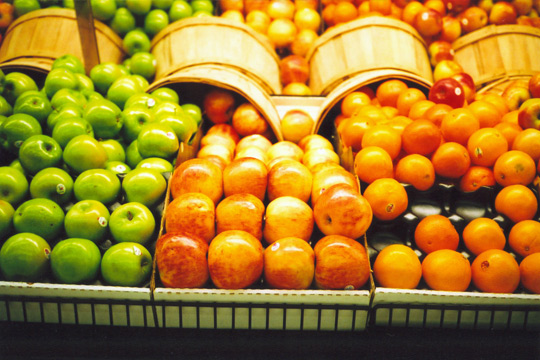
Reducing Food Waste in Foodservice
October 16, 2018 by Doreen Garelick, Dietetic Intern
Our intern Doreen attended a food waste summit for restaurants and compiled these tips to help food service operators redirect…
Nutrition 101
September 20, 2013

Find out how Jason Lau, R.D., gets his grocery shopping done quickly and healthfully.
Just like most other professionals working in the city, I don’t have much time to dedicate to grocery shopping. As a registered dietitian, I try to cook at home a few times a week, so when it’s time to grab my weekly produce (often during the supermarket rush hour after work) I tend to shop as quickly as possible. Here are some of my tips for how to navigate the supermarket smartly and save some time:
When you first enter the supermarket, try to stick to the outer path and avoid the middle part of the store. Most of the fresh produce and chilled foods are typically located on the outer aisles. Moreover, you can find the resident butcher and bakery along the outermost route of the store to pick up your fresh meats and bread. On the contrary, the inner aisles are full of processed foods such as candies, chips or high-sodium sauces (learn how to quickly make your own simple marinara sauce). So make sure to fill up your cart mostly with produce from the outer aisles.
Now that you know which aisles to try and stick to, you might ask what specific produce you should be putting into your cart. A simple rule is to include a variety of food items from all colors of the rainbow. Different colored fruits and vegetables provide different vitamins, minerals and antioxidants; by eating a colorful diet, you are already on your way to meet your micronutrients requirements. Also, stick with seasonal produce where possible. Produce typically contains more nutrients when in season. Fruits and vegetables like leeks, apples and Brussels sprouts are in season right now, so be sure to pick some up next time you’re at the grocery store.
The food label on each product does not just provide you with nutritional breakdown of the product itself (learn more about how to easily read food labels); it also shows you the ingredients of the product from the most abundant to the least. Typically, you should try to purchase products that contain 5 ingredients or less. Products with long lists of ingredients or unrecognizable terms are usually more processed and contain higher sodium. As a rule, the simpler the food is, the better it is for you.
Live smart and eat healthy!
Do you have any tips for navigating the supermarket quickly and healthfully? Let me know in the comments section below.

October 16, 2018 by Doreen Garelick, Dietetic Intern
Our intern Doreen attended a food waste summit for restaurants and compiled these tips to help food service operators redirect food waste from landfills.
Nutrition 101

Nutrition 101
September 26, 2018 by Doreen Garelick, Dietetic Intern
Ever notice headlines about rapid weightloss? Dietetic Intern Doreen Garelick looks deeper into a recent eye-catching headline to see if there's any truth behind it.
Connect
 Follow us on Twitter
Follow us on Twitter Friend us on Facebook
Friend us on Facebook Follow us on Pinterest
Follow us on Pinterest Follow us on Instagram
Follow us on Instagram Read our Blog
Read our Blog Watch videos on YouTube
Watch videos on YouTube Watch videos on Vimeo
Watch videos on Vimeo Connect with us on Linkedin
Connect with us on Linkedin Find us on Foursquare
Find us on Foursquare
Tweets by @SPEcertifiedBlog Search
Categories
SPE Certified Newsletter
Sign up for news on the latest SPE-certified venues, events and SPE updates.
We will never share your personal information with a third party.